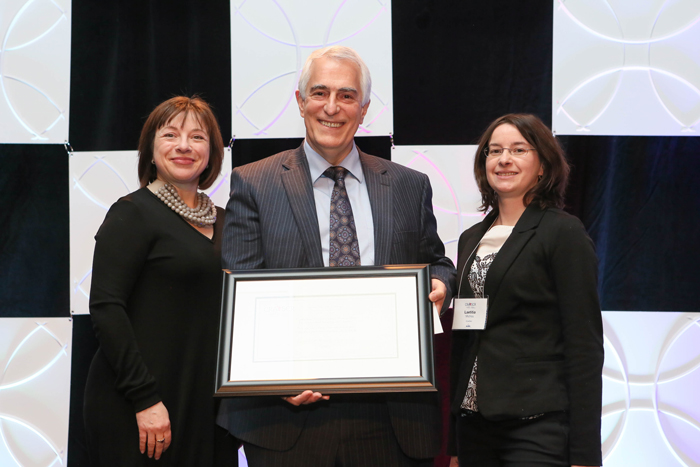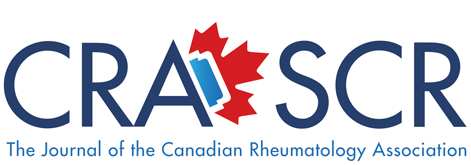Summer 2017 (Volume 27, Number 2)
Distinguished Investigator:
Dr. Jacques Brown
Download PDF
What was your first thought when you learned that you would receive this award?
I first heard about this award on a voicemail – I was travelling and the CRA office couldn’t reach me in time to make an official announcement. I was highly surprised and delighted since my area of research is somewhat outside the usual fields of expertise found in Canadian rheumatology.
Why did you become a rheumatologist? What or who influenced you along the way to do so?
As a first year trainee in Internal Medicine at Laval University in Quebec City, I was attracted by two subspecialties, rheumatology and neurology, which both at that time offered great diagnostic opportunities, but limited therapeutic options. I ended up choosing rheumatology because I had an excellent rotation in the Rheumatology Division at Le Centre Hospitalier de l’Université Laval (CHUL) headed by Dr. Lucien Latulippe. I have been most impressed by Dr. Gilles Mathon’s passion and Dr. Jean-Yves Lang’s wisdom. Together with Dr. Monique Camerlain in Sherbrooke, they convinced me that rheumatology was a subspecialty where we pay enormous attention to patient needs. My interest for clinical research was nurtured by Drs. André Lussier and Henri Ménard when I trained in rheumatology at Sherbrooke University. As a research fellow of the Arthritis Society, Dr. André Lussier mentored me through a two-year postdoctoral training in metabolic bone diseases at the Institut National de la Santé et de la Recherché Médicale (INSERM) unit directed by Professor Pierre J. Meunier in Lyon, France.
What do you believe are the qualities of a distinguished investigator?
First, you need a great deal of passion for what you do, to make your hard work enjoyable and sustainable. As physicians, our research questions come from clinical unmet needs and a high level of confidence that if you don’t address the problem yourself, there is a risk that no one else would do so. Collaborators are key to your success since you can’t have all the expertise needed in a single researcher, no matter how talented he or she is. Finally, improvement of patient care should always be at the centre of our research activities.
You established the Groupe de recherche en rhumatologie et maladies osseuses that became the catalyst for a productive research program that combined innovative laboratory-based research, clinical trials and large cohort studies. You have been co-principal investigator on the Canadian Multicenter Osteoporosis Study (CaMos). What are some of the major breakthroughs you’ve had with your research?
The most important one was the discovery in 2001, of the first and (still) only gene associated with Paget’s disease of bone on Chromosome 5q35 tel: a recurrent mutation of the gene encoding sequestosome 1 (SQSTM1/p62). The enormous cost associated with the phenotypic characterization of close to one thousand subjects was covered by reinvesting the money generated from clinical research grants received from the pharmaceutical industry. This discovery has favoured the establishment of a young researcher in our institution, Dr. Laëtitia Michou, who now leads our research program on the genetics of Paget’s disease of bone and rare genetic bone diseases.
I am also very proud of our epidemiological cohort research CaMos and the Recognizing Osteoporosis and its Consequences in Quebec (ROCQ) programme which brought back an esteemed young researcher to our unit, Dr. Louis Bessette. Both studies provided unique epidemiological data on osteoporosis, defining fragility fractures, clinically meaningful vertebral fractures, morbidity and mortality as well as financial costs associated with this debilitating disease.
All this was made possible by the dedicated and hard work provided by our talented clinical research nurses, our manager, as well as our administrative assistant, who all handled the growing complexity of clinical research standard operating procedures.
Are there other areas of interest you would like to investigate in the future? What projects will you be undertaking in the near future?
Over the last few years, I have investigated the causes of atypical femur fractures (AFFs), a very rare but serious adverse event affecting patients on long-term bisphosphonate therapy for osteoporosis. AFFs are “insufficiency” or “stress” fractures related to impaired bone material properties. In parallel, I have identified a family suffering from spontaneous AFFs in adults. We are currently investigating the genetic factors involved, with the hope of finding genetic markers that could be used to screen patients at risk of developing AFF when treated with bisphosphonates.
How does your research influence the clinical care of patients? What are you able to translate from research lab to examining room?
Early identification of patients with Paget’s disease of bone and those at risk for AFF will greatly improve clinical care. Our epidemiological research contributed to improved knowledge of the disease processes and clinical management of osteoporosis and related fractures.
What have been the most rewarding aspects of going into the field of rheumatology and what have been some of the most challenging aspects?
The most rewarding has been to observe and contribute to the fabulous growth in our knowledge of the various rheumatic disease processes and the development of numerous new therapeutic options improving our patient care, as well as receiving gratifying recognition from our patients.
The most challenging aspect was to somewhat fail in moving osteoporosis and metabolic bone diseases to a higher priority level among the funding agencies and healthcare stakeholders.
You are marooned on a desert island? What book would you like to have on hand with you?
The Bible, being a practicing Roman Catholic. On a darker note, I would also like to re-read “The Godfather” by Mario Puzo, which illustrates the deleterious consequences of “the end justifies the mean” – something to always keep in mind during a successful career in a very competitive environment!
You are handed a plane ticket to anywhere in the world. Where do you go?
I would go to Scotland with my family to visit the homeland of our ancestors.
What advice would you give to someone looking to pursue a career as an academic rheumatologist?
Not everyone needs to pursue an academic career to be an excellent practicing rheumatologist, but if you’re passionate and a hard worker, it is the easiest way to achieve excellence.
Are you considering retirement? What would you do if you were not a rheumatologist?
I am considering retirement within the next five years. I would have loved to be an airplane pilot.
Jacques Brown, MD, FRCPC
Clinical Professor of Medicine,
Department of Medicine, Laval University
Rheumatologist, CHU de Québec-Université Laval
Quebec City, Quebec

Dr. Jacques Brown received his award from Dr. Joanne Homik and Dr. Laëtitia Michou.

|
